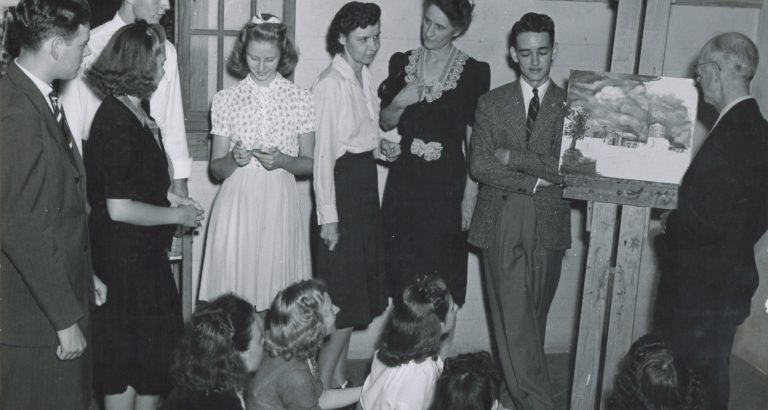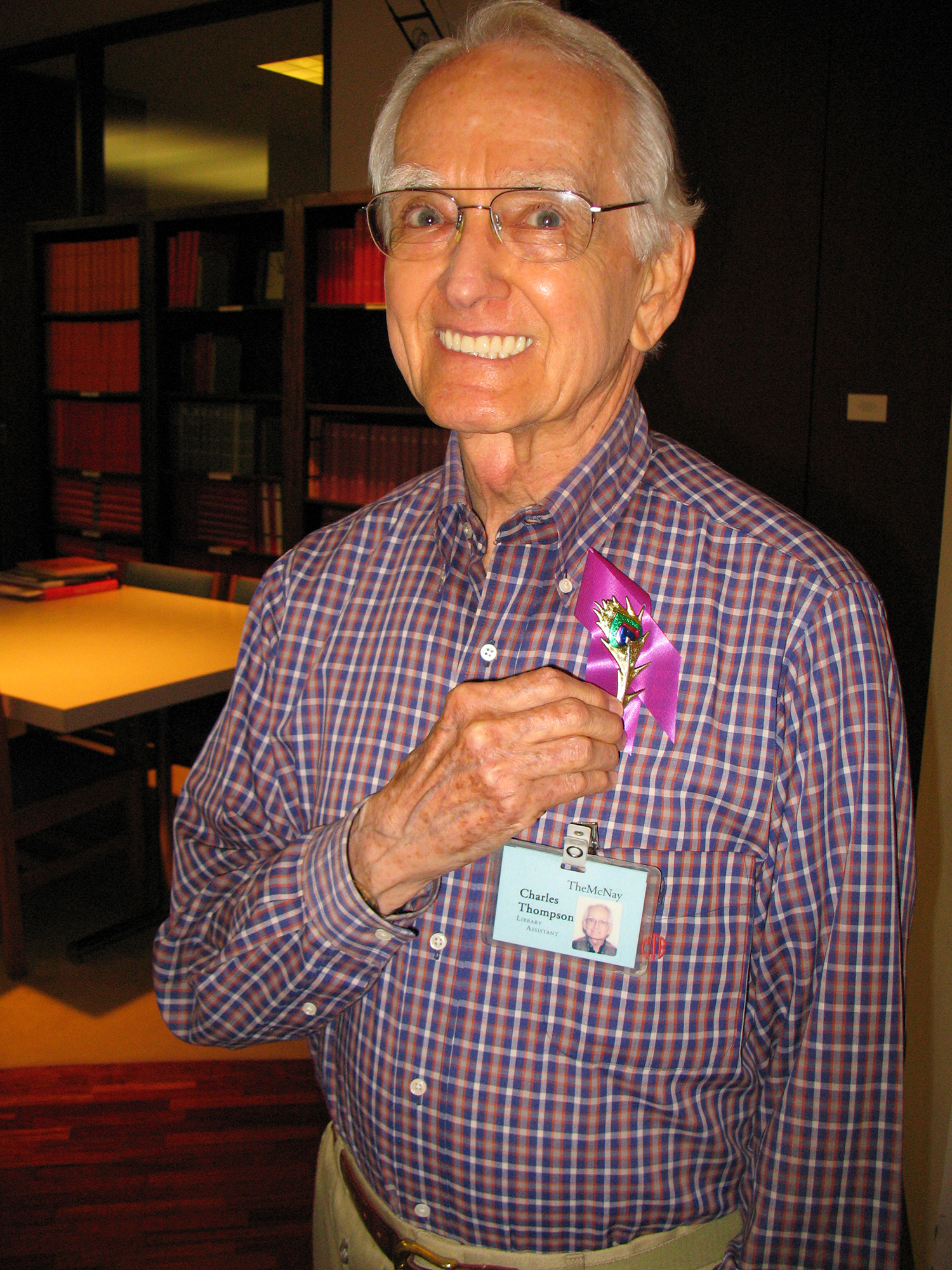
A Fond Farewell to Charles B. Thompson, Longtime Library Assistant at the McNay
There’s no doubt that September 2016 marks a significant transition for the McNay Art Museum as staff say “au revoir” to long-time director Dr. William J. Chiego, and “bienvenido” to incoming director Dr. Rich Aste. As the McNay marks this celebratory milestone transformation with an eye towards a future of leadership at the helm of Rich Aste, there is also a quiet undercurrent of sadness among museum staff as we collectively mourn the loss of one of our own. On August 31, Library Assistant Charles B. Thompson passed away leaving a hollowed sense of void within the library department, and museum as a whole.
How does one appropriately pay respect to an individual such as Charles Thompson who, though many may not realize, had a life-long engagement with the McNay? What sort of tribute is fitting for such a humble, generous, and special individual? How will we ever manage without him? I’m not so certain I have the answers to those questions, but I will do my best to try and share with you some of the many facets that made Charles an extraordinary individual.
 |
| Charles Thompson with his Peacock Feather Volunteer Award Pin, 2008 |
Museum staff and guests who visited the McNay Library over the course of the past 20+ years might remember seeing Charles, a friendly, well-dressed, older gentleman who regularly sat at one of the computer workstations diligently typing away. Perhaps Charles helped you locate a book from the stacks or pulled an artist vertical file to help with your research? His organizational skills and dedication to the library helped keep the endless inflow of new books and artist resources moving in the right direction to ensure future access and retrieval. Did I mention his penmanship was simply exquisite? In fact, I would often enlist his services to help with labeling archival file folders, which requires one to write in pencil as legibly as possible, using all capital letters to avoid confusion between the letters “o” and “a”; “i” and “l”; “f” and “t”. Needless to say, Charles was a constant, albeit quiet presence during the library’s public service hours, waiting in the wings, always ready and willing to help wherever needed.
In my opinion, one could say the library’s artist vertical file collection was Charles’s baby. Though this was not his only responsibility, he alone was the primary individual responsible for maintaining that collection, which numbered 27,285 individual artists’ files as of Sep 1. He would be very proud of that number. I recall how from time to time he would spontaneously announce the ever-growing number of artists’ files with a sense of amazed accomplishment, and rightfully so. That’s because on a daily basis Charles would ensure that all incoming ephemera was filed appropriately; he also maintained the accompanying database. The artists’ vertical files are currently immaculate; amazingly he’s kept every single clipping arranged in chronological order and even created (and regularly updated) inventoried spreadsheets for each file. This work alone speaks volumes to my question “How will we ever manage without him?”
Did you know that Charles was himself a noted artist? Indeed he was. As a matter of fact, one can find an entry on Charles in the reference book titled Texas painters, sculptors & graphic artists: a biographical dictionary of artists in Texas before 1942 where he was described as a “San Antonio Painter, commercial artist, antique dealer, interior designer.” It’s obvious that each one of those four distinctions culminated from a lifetime of experiences and could merit a blog in its own right. Sadly, I never had the opportunity to see one of his paintings in person. In working alongside Charles for the past fourteen years I understood him to be a private individual. He didn’t talk much about himself, but at the same time he would happily answer questions and open up in conversation when the opportunity was presented. From time to time Charles would surprise me by bringing in a few personal mementos to show and tell. I always enjoyed those special moments.
 |
| Clipping from TJHS’s newspaper, The Declaration, May 1941 |
It came as no surprise to learn that his artistic ability was recognized at an early age. I fondly recall on one occasion when Charles brought in a small collection of his old photographs, which dated from ca.1941 when he attended Thomas Jefferson High School (coincidentally, my high school alma mater as well!). The photographs documented the occasion Charles was sworn in as President of the Thomas Jefferson Fine Arts Society at the Mill Race Studio in Brackenridge Park. You can see Charles in the photograph below standing in front of his fellow students, alongside the artist Charles Rosen—that’s one of Charles’s paintings displayed on the easel. Thankfully he allowed me to digitally scan copies of those photographs for the archives!
 |
| Thomas Jefferson High School Fine Arts Society, Installation of Officers at Mill Race Studio, 1941 |
Another noteworthy fact regarding Charles’s artistic achievements is that in 1946, at the age of 20, he was acknowledged as the Onderdonk Prize Winner for the San Antonio Art League’s Annual Artist Exhibition. Interestingly, 1946 is the same year that Charles was discharged after serving 2.5 years as a map draftsman with the Engineering Photo-mapping Battalion in Portland, Oregon, and the Philippine Islands AND subsequently enrolled as a Veteran under the GI Bill in Commercial Art classes at the San Antonio Art Institute. Some of these art classes were held on the grounds of Mrs. McNay’s palatial, art-filled private estate. Records indicate the former San Antonio Art Institute was approved for training Veterans under the GI Bill (Public Law 346) and Charles was enrolled in the Commercial Art program during the 1946-47 school term. At the San Antonio Art Institute, Charles honed his skills studying under noteworthy artists such as Warren Hunter, Dan Lutz, Richard Haines, and Etienne Ret. After 34 weeks of study, he was issued a certificate in “Commercial Art & Painting” on May 31, 1947.
Yet another amazing aspect about Charles was his ability to answer all sorts of random reference questions I might have had about old San Antonio, especially the former San Antonio Art Institute because of his connection to the art school. However, the art school was not his earliest brush with the McNay estate. In fact, Charles relayed his memory of regularly visiting the estate grounds when he was a child, as early as 1931—about one year after Dr. and Mrs. Atkinson (Marion McNay) completed construction on their new home. At that time, his father’s sister Vivian Henry was living on the estate grounds in the original farmhouse with the head-gardener Bertram (Bert) Batten. Charles explained how Bert “often advised us that we should pay a visit to the estate at particular times so that we could enjoy all the blooming flowers that had been put in the ground along walkways, et cetera, on the occasion of an approaching Atkinson party.” Another draw to the estate grounds was his parents’ need for a source of fresh goat milk for Charles’s younger brother. Charles’s aunt Vivian informed his parents about the herd of Nubian goats kept by Dr. and Mrs. Atkinson (Marion McNay) on their property, and thus a source for goat’s milk was found. Certificates from the American Milk Goat Record Association on file in the museum archives indicate Mrs. McNay housed both the Anglo-Nubian and Toggenburg breeds. Best of all, the photograph below shows Charles about age six, which was taken on the estate grounds among Marion’s herd of goats.
 |
| Charles Thompson on the estate grounds, with Marion McNay’s Nubian goats, December 1931 |
In the 1950s Charles spent some time in Houston studying Interior Design at the Feather and Feather School of Design before becoming employed for a few years at the reputable interior-design firm Eugene Harris & Virginia West Interiors. Shortly thereafter he returned to San Antonio and opened his own retail shop called ACCENTS with business partner Bob Garman. I’ll never forget the one time Charles brought in his collection of photo albums to share, which documented his retail shop. The albums were chock-full, cover-to-cover with wonderful Kodachrome color photographs of the interior of ACCENTS. What I wouldn’t give to see those albums once again! From time to time, guests visiting the McNay library who had been familiar with his retail shop would surprisingly find Charles working among the books and he always remembered everyone by name. Sometimes those individuals may not have noticed his presence, but after their visit Charles would later tell me how they used to be his regular clients. Charles operated his retail shop for 34 years before selling the business. It seems many longtime San Antonians affectionately remember shopping at ACCENTS, and I’m sure they remember Charles too!
 |
| ACCENTS advertisement Clipping, 1980 |
Even before Charles worked in the interior design business, he had gained considerable retail experience in the late 1940s while becoming “completely involved” in assisting his parents with their prosperous flower shop, “Dorothy Thompson, Florist”. After Charles’s father passed away in 1984, his mother Dorothy, who had spent her life working, became a library volunteer at the McNay and worked in retirement with Librarian Pat Blackman for five years. In 1990, before moving with this mother to Tyler, Texas, the McNay’s first director John Leeper hosted a farewell party for his mother at the museum.
 |
| Dorothy and son Charles Thompson with Pat Blackman at the Farewell Party for Dorothy Thompson, Nov. 11, 1990 |
After spending three years in Tyler, Charles and his mother returned to San Antonio in 1993. When his mother passed away in 1999, Charles thereafter followed in his mother’s footsteps and himself became a library volunteer at the McNay under the leadership of Head Librarian Ann Jones. Charles continued volunteering with the McNay for many years before officially joining the museum staff in the summer of 2008, just as the new Stieren Center for Exhibitions opened to the public. It’s hard to believe the McNay’s Stieren Center has already been open for over eight years! Even more so, it’s difficult for us to accept that Charles is now gone. He will be missed.
 |
| Charles Thompson with Head Librarian Ann Jones at the McNay’s Annual Volunteer Appreciation Party, 2006 |
Sources:
Powers, John E. and Deborah D. Powers. Texas painters, sculptors & graphic artists: a biographical dictionary of artists in Texas before 1942. Austin: Woodmont Books, 2000.
Thompson, Charles.“Reflections on the Atkinson and McNay Estates and the McNay Art Museum.” 2011.
San Antonio Art Institute Collection. McNay Art Museum Archives, San Antonio, Texas. 09 Sep. 2016.
Images 1, 6 and 7 courtesy: McNay Art Museum Archives, Photo Collection
Images 2, 3, and 4 courtesy: McNay Art Museum Archives, Charles Thompson Collection
Image 5: ACCENTS. “McNay Art Institute: The first 25 years.” Supplement to The North San Antonio Times (San Antonio, TX), Feb. 28, 1980









